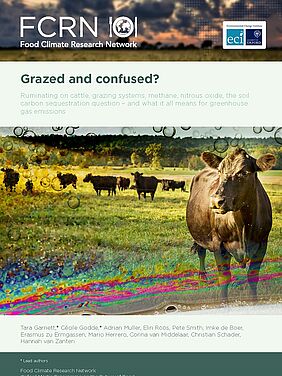The newly published report dissects claims made by different stakeholders in the debate about so called 'grass-fed' beef, the greenhouse gases the animals emit, and the possibility that, through their grazing actions, they can help remove carbon dioxide from the atmosphere. It evaluates these claims and counterclaims against the best available science, providing an authoritative and evidence-based answer to the question: Is grass-fed beef good or bad for the climate?
"Grazed and Confused? Ruminating on cattle, grazing systems, methane, nitrous oxide, the soil carbon sequestration question – and what it all means for greenhouse gas emissions" is written by Dr Tara Garnett of the Food Climate Research Network at the University of Oxford, Cécile Godde at Australia’s national science agency the CSIRO and a team of international experts including FiBL. The report finds that while grazing of grass-fed animals can boost the sequestration of carbon in some locally specific circumstances, that effect is time-limited, reversible, and at the global level, outweighed by the greenhouse gas emissions they generate.
This statement is focusing on the climate change mitigation potential and the report focused on correcting certain overly optimistic claims with this regard. It is, however, not meant that in consequence grain-fed livestock should be supported.
Rather, this finding on the climate performance is a strong argument to enlarge the discussion and to complement assessments related to climate change with other aspects. Grass-fed animals are, for example, able to turn resources that cannot be utilized for human consumption into food, which otherwise would not be possible. The aim is thus to not focus on efficiency only (emissions per kg of product) but also on consistency (i.e. the optimal use of resources within a food systems context) and sufficiency (the total production and consumption level). Reducing the production and consumption of animal-sourced food provides the space to focus on grass-fed animals as a consistency strategy, even though their emissions per kg of product may be higher. Due to the generally lower production level, overall emissions are then reduced as well. The big leverage thereby is the level of animal products, not the fact that they are grass-fed or otherwise. For a more in-depth discussion of some of these aspects, please see section 5.4.1 ("Livestock on leftovers: a grassfed future") in the report.
Contains excerpts from the press release "Grazed and confused?" from the Food Climate Research Network
Further information
Contact
Adrian Müller, FiBL Switzerland




